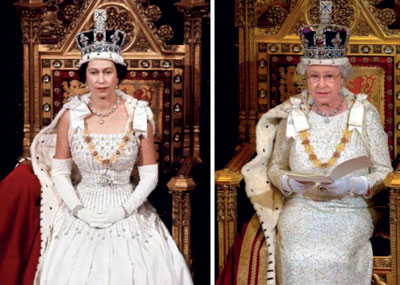Elizabeth Alexandra Mary Windsor wasn’t born to wear the crown. But destiny intervened. The woman who became Queen Elizabeth II will mark 70 years on the throne Sunday, an unprecedented reign that has made her a symbol of stability as the United Kingdom navigated an age of uncertainty.
From her early days as a glamorous young royal in glittering tiaras to her more recent incarnation as the nation’s grandmother, the queen has witnessed the end of the British Empire, the advent of multi-culturalism, the rise of international terrorism, and the challenges posed by Brexit and the COVID-19 pandemic. In a world of relentless change, she has been a constant — representing the U.K.’s interests abroad, applauding the nation’s successes and commiserating in its failures, and always remaining above the fray of politics.
That constancy should earn Elizabeth a royal epithet like those of her predecessors such as Wil-liam the Conqueror, Edward the Confessor and Alfred the Great, said royal historian Hugo Vickers.
“I’ve always thought she should be called Elizabeth the Steadfast,” Vickers told The Associ-ated Press. “I think it’s a perfect way of describing her. She wasn’t necessarily expecting to be queen, and she embraced that duty.’’
As the elder daughter of King George V’s sec-ond son, Elizabeth, now 95, was expected to live the life of a minor royal when she was born on April 21, 1926. Dogs and horses, a country house, a suitable match — a comfortable but uneventful life — seemed her future.
But everything changed a decade later when her uncle, King Edward VIII, abdicated so he could marry the American divorcee Wallis Simpson. Elizabeth’s father became King George VI, making the young princess heir apparent.
George VI, whose struggles to overcome a stut-ter were portrayed in the 2010 film “The King’s Speech,” endeared himself to the nation when he refused to leave London as bombs fell during the early months of World War II.
Elizabeth followed her father in leading by ex-ample, joining the Auxiliary Territorial Service in early 1945, becoming the first female member of the Royal Family to join the armed services as a full-time active member. On her 21st birthday, she dedi-cated her life to the nation and the Commonwealth, the voluntary association of states that grew out of the British Empire.
“I declare before you all that my whole life, whether it be long or short, shall be devoted to your service and the service of our great imperial family to which we all belong,” she said in a radio address broadcast around the world.
In 1952, the young princess embarked on a tour of the Commonwealth in place of her ailing father. She was at a remote Kenyan lodge, where she and her husband Prince Philip watched baboons from the treetops, when she heard her father had died.
She immediately returned to London, disem-barking the plane in black mourning clothes, to begin her life as queen. She has reigned ever since, with crown and scepter on big occasions, but more commonly wearing a broad-brimmed hat and carry-ing a simple handbag.
In the intervening seven decades, the queen has shared confidences with 14 prime ministers and met 13 U.S. presidents.
Once a year, she travels the mile or so from Buckingham Palace to the House of Lords for the ceremonial opening of Parliament. And when world leaders come to call she hosts state banquets during which her diamonds flash under the TV lights and presidents and prime ministers worry about whether to bow and when to offer a toast.
But it is the less lavish events that give the queen a link to the public. At the garden parties that honor the service of everyone from soldiers and charity workers to long-serving school librarians and crossing guards, guests wear festive hats and drink tea as they try to catch a glimpse of the queen on the lawn outside Buckingham Palace. The hon-orees can spot her at a distance, as it is said she favors bright colors so the public can spot her in a crowd.
Then there is the annual wreath laying at the memorial to those who have died during conflicts around the world, as well as the numerous school openings, hospice visits and tours of maternity wards that have filled her days.
Britain’s longest-serving monarch, the only sov-ereign most Britons have ever known, has been a constant presence from the Suez Crisis of 1956, when Egypt’s seizure of the Suez Canal underscored Britain’s declining might, through the labor strife of the 1980s and the 2005 terror attacks in London..
When Prince Philip died during the pandemic, she donned a black face mask and sat alone during his socially distanced funeral, silently demonstrating that the rules applied to everyone — particularly her.
“She’s not beholden to the electorate. She’s not dependent on her latest hit or her latest movie,’’ said Emily Nash, royal editor of HELLO! magazine. “She’s just there. She does what she does. She car-ries out her duties without ever complaining or mak-ing any personal drama. And people respect her for that.”—AP










